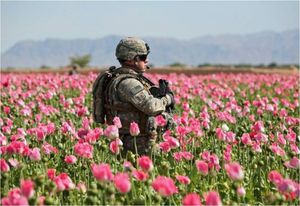
en francais ici
“reconstruction,” helping raise, fund, equip, and train an army of 350,000 Afghan allies, and still not be able to pacify one of the world’s most impoverished nations? So dismal is the prospect for stability in Afghanistan in 2016 that the Obama White House has recently cancelled a planned further withdrawal of its forces and will leave an estimated 10,000 troops in the country indefinitely.
Were you to cut through the Gordian knot of complexity that is the Afghan War, you would find that in the American failure there lies the greatest policy paradox of the century: Washington’s massive military juggernaut has been stopped dead in its steel tracks by a pink flower, the opium poppy.
For more than three decades in Afghanistan, Washington’s military operations have succeeded only when they fit reasonably comfortably into Central Asia’s illicit traffic in opium, and suffered when they failed to complement it. The first U.S. intervention there began in 1979. It succeeded in part because the surrogate war the CIA launched to expel the Soviets from that country coincided with the way its Afghan allies used the country’s swelling drug traffic to sustain their decade-long struggle.
On the other hand, in the almost 15 years of continuous combat since the U.S. invasion of 2001, pacification efforts have failed to curtail the Taliban insurgency largely because the U.S. could not control the swelling surplus from the county’s heroin trade. As opium production surged from a minimal 180 tons to a monumental 8,200 in the first five years of U.S. occupation, Afghanistan’s soil seemed to have been sown with the dragon’s teeth of ancient Greek myth. Every poppy harvest yielded a new crop of teenaged fighters for the Taliban’s growing guerrilla army.
At each stage in Afghanistan’s tragic, tumultuous history over the past 40 years -- the covert war of the 1980s, the civil war of the 1990s, and the U.S. occupation since 2001 -- opium played a surprisingly significant role in shaping the country’s destiny. In one of history’s bitter twists of fate, the way Afghanistan’s unique ecology converged with American military technology transformed this remote, landlocked nation into the world’s first true narco-state -- a country where illicit drugs dominate the economy, define political choices, and determine the fate of foreign interventions....
http://www.tomdispatch.com

No hay comentarios:
Publicar un comentario